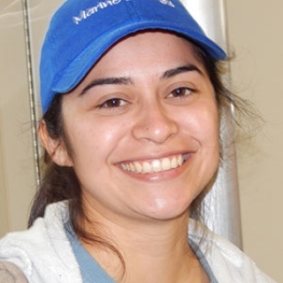Eight students will be presenting the summer work at the Ocean Sciences Meeting in March 2022!
Alison Aceves, California State University, Monterey Bay
Class Year:
2015Mentor:
James Pierson, Ph.D.Project Title:
The Impact of Irradiance and Ammonium on the Mixotrophic Response by the Winter Bloom Heterocapsa rotundata in the Chesapeake Bay
Abstract:
Mixotrophic plankton are capable of obtaining their energy through photosynthesis and phagocytosis, and have been observed to be common among marine and freshwater dinoflagellates. The role of mixotrophic dinoflagellates in the ‘microbial loop’ has received little attention. Organisms that were only thought to introduce new carbon into the loop through photosynthesis may also consume fixed carbon by ingesting bacteria, making the ‘microbial loop’ more complex that originally conceived. The nanodinoflagellate Heterocapsa rotundata was cultured under various light and nutrient regimes to investigate the role of phototrophy and phagotrophy during winter conditions in the Chesapeake Bay. We quantified grazing rates of H. rotundata on bacteria using two feeding methods, ingestion of polycarbonate microspheres and prey removal experiments. Ingestion of fluorescent microspheres by H. rotundata revealed their ability to phagocytize particles. Using flow cytometry we calculated grazing rates of H. rotundata on bacteria under various light intensities and ammonium concentrations and found that H. rotundata increased phagotrophy at lower light intensities and ammonium was positively correlated with the grazing rates of H. rotundata. We conclude that H. rotundata uses mixotrophy as a primary source for obtaining carbon during the winter when there is limited light and low temperatures.
Blog post:
See Alison's post to Fellowship Experiences, Maryland Sea Grant's blog written by and about fellows and their research: "This Chesapeake Bay Phytoplankton Finds Multiple Ways to Snack."
Location:
Horn Point LaboratoryREU Update
Received Masters from Auburn University and is a Fish Health Biologist at Utah Division of Wildlife ResourcesPublications:
Millette, N., J. Pierson, A. Aceves*, and D. Stoecker. 2016. Mixotrophy in Heterocapsa rotundata : A mechanism for dominating the winter phytoplankton . Limnology and Oceanography 62:836-845 .
Millette, NC; Pierson, JJ; Aceves, A; Stoecker, DK. 2017. Mixotrophy in Heterocapsa rotundata: A mechanism for dominating the winter phytoplankton. . Limnology and Oceanography .
Presentations:
Aceves, A.*, J. Pierson, and N. Millette. 2015. Measuring grazing rates of the winger bloom-forming Heterocapsa rotundata using 2 methodologies . SACNAS Annual Meeting, Washington, District of Columbia .
Aceves, A.* and J. Pierson. 2016. Mixotrophy in the winter bloom-forming Heterocapsa rotundata: Quantifying grazing rates using two methodologies . Ocean Sciences Meeting, New Orleans, Louisiana .



